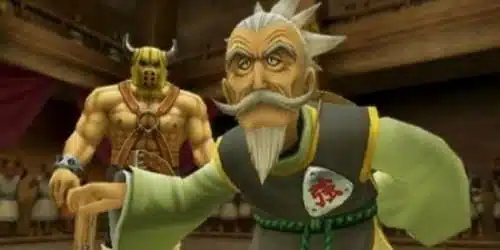
One of the most interesting things about the Wii’s release and relative dominance, sales-wise, when compared to this generation’s other two major consoles, is that Nintendo’s little machine that could has redefined exactly what a gamer is, and what a gamer can be. The truth is, in most cases, you can tell a lot about the gamer who has chosen to drop $250 on a Wii — the gamer who buys a Wii would rather play with other people in the room than online, for instance, and is willing to sacrifice graphical power for the sake of potential new ways of being engaged. The gamer who buys a Wii is one who finds Nintendo’s distinct style appealing, and probably has an appreciation for the classic games in Nintendo’s most recognizable series.
What is a third party developer to do, but appeal to the target audience of a console when it makes a game exclusive to that console?
This is why we have games like Dragon Quest Swords: The Masked Queen and the Tower of Mirrors.
Despite its unwieldy subtitle, Dragon Quest Swords is actually a rather severe simplification of the Dragon Quest / Dragon Warrior series. Dragon Quest first appeared in the late ’80s as a rather basic but very well put together turn-based role-playing game. The graphics have gotten better, the gameplay more complex, but the exploration, treasure-hunting, and kingdom-saving have all pretty much remained the same. Even the game’s most recognizable baddies have remained consistent throughout the series, a series whose proper releases now number a full eight, with a ninth on the way (exclusively for the Nintendo DS, oddly enough).
The things that Dragon Quest Swords borrows from the original series are fairly predictable ones for the most part. There are slimes here, and golems, too. There’s a silent warrior whose sole duty it is to save the kingdom. There are shops at which to buy bigger, better weapons and armor, and a handful of NPCs around to progress the plot and provide gently humorous banter.
Still, 8ing did keep the differences of the Wii audience in mind when they put together Dragon Quest Swords, and what we get is a simplified — some would say dumbed down — version of the role-playing experience. Example: There’s only one town, from which you embark on each of the separate adventures that make up the game. The game is arranged episodically, and each of your adventures is something of a first-person on-rails experience. The same enemies show up in the same places every time you progress through one of the predetermined paths, attacking the same way every single time. You return to the town after an episode, and subtle little things change, but for the most part, it’s a pattern of walk around town, talk to everyone, buy some new weapons, go fight, and repeat. Role-playing lite.
What’s truly odd is that of all of the similarities and differences between the primary series and this particular offshoot, one of the most universally despised parts of the role-playing experience made it through the translation: grinding.
Anyone who has played an RPG knows the pain of having to walk around in the great outdoors, waiting for randomly-placed battle after randomly-placed battle to occur, all in the name of building experience points for long enough that your character is strong enough to take on the next bunch of bad guys necessary to progress the plot. It’s an artificial way of lengthening the time it takes to beat the game, and it’s a rather frustrating, not to mention boring way to spend time.
On average, you’ll play the episodes of Dragon Quest Swords twice; some less, some more. Granted, there are some separate paths that you can take to look for treasure and change up the experience a bit, but for the most part, it’s the exact same experience multiple times for the sake of getting ready to progress through the main storyline. Perhaps it’s for the best, however, as without the grinding, the whole thing might only take five or so hours to get through.
There are, of course, a few special touches tossed in here to take advantage of the Wii’s unique control system. You get to wave the remote around to use your sword and shield, a mechanic that works pretty well, although the diagonal sword-waving seems a bit unreliable at times. One can only imagine what a nightmare such controls must be to implement, and 8ing did an admirable job in their attempt.
The question remains, however, of whether Dragon Quest Swords will reach the audience that it’s catering to. The Dragon Quest name is bound to appeal primarily to those familiar with the previous games in the series and the history of Dragon Quest / Dragon Warrior; for American audiences who might not have played a Dragon Quest game in almost 20 years, using the old Dragon Warrior name might actually have done a better job to court the hearts and memories of those who may have fond memories of bashing their way through a game as a descendent of Erdrick. Get past the name, and the game doesn’t present itself as much more than a typical questing game with a Japanese art style.
That said, those who do take the plunge are in for a hack ‘n’ slashing good time, at least for ten hours or so. Despite the cuts made to the role-playing experience, Dragon Quest Swords does a decent job of presenting a fully developed game without many of the intimidating aspects of the genre it draws from.
Still, we really could have done without the grinding.

